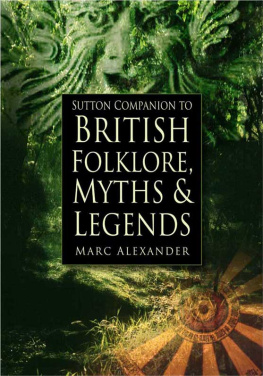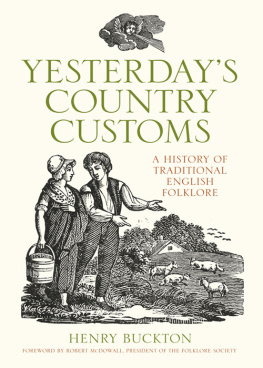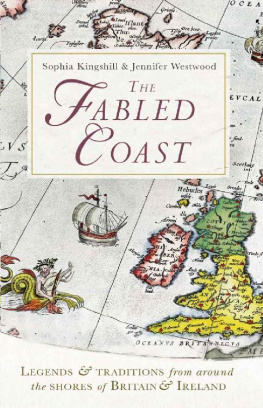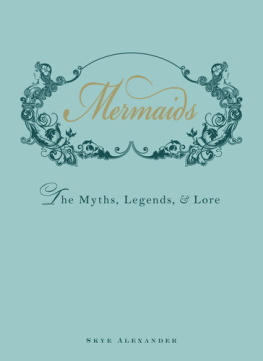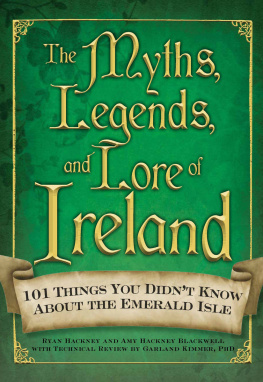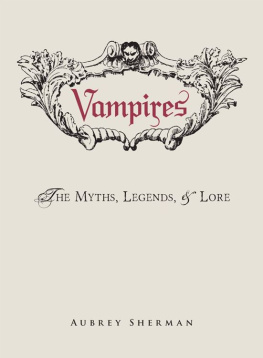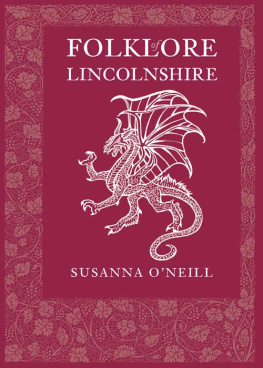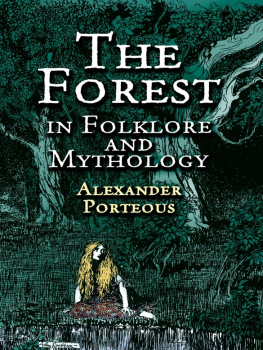A Companion to the
Folklore,
Myths &
Customs
of Britain
There never was a merry world
since the fairies left off dancing.
John Selden (15841654)
A Companion to the
Folklore,
Myths &
Customs
of Britain
MARC ALEXANDER

First published in the United Kingdom in 2002 by
Sutton Publishing Limited
This paperback edition first published in 2005
Reprinted 2006
The History Press
The Mill, Brimscombe Port
Stroud, Gloucestershire, GL5 2QG
This ebook edition first published in 2013
All rights reserved
Marc Alexander, 2002, 2013
The right of Marc Alexander to be identified as the Author of this work has been asserted in accordance with the Copyright, Designs and Patents Act 1988.
This ebook is copyright material and must not be copied, reproduced, transferred, distributed, leased, licensed or publicly performed or used in any way except as specifically permitted in writing by the publishers, as allowed under the terms and conditions under which it was purchased or as strictly permitted by applicable copyright law. Any unauthorised distribution or use of this text may be a direct infringement of the authors and publishers rights, and those responsible may be liable in law accordingly.
EPUB ISBN 978 0 7509 5427 3
Original typesetting by The History Press
ACKNOWLEDGEMENTS
Firstly I must express my gratitude to Paul Abrahams whose help with the preparation of this Companion has been beyond the call of friendship; equally I am indebted to Olivia Davies and Jennifer Hassell.
Invaluable assistance has been generously provided by the Dean and Chapter of Canterbury Cathedral, the Dean and Chapter of Winchester Cathedral and the Dean and Chapter of Westminster Abbey; also the Brewers Society, the British Library, the British Museum, the Colindale Newspaper Library, the English Folk Dance and Song Society, the Folklore Society, The National Trust, the Salem Witchcraft Museum, the Society for Psychical Research, and Caroline Marten of the Rosslyn Chapel Trust.
I also wish to express my appreciation of the help I have received in collecting material over the years, and in the preparation of this book, from Revd J.M. Allen, Tom Arnold, Harold Bailey, Anne Bennett, Arthur Blythe, Revd Wilfrid Braithwaite, Revd Victor Bullock, Barbara Cheeseman, John Clapp, John Clarkson, Sarah Cook, Michael Crickett, Jane Crompton, Owen Daish, Peter Davis, David Dorman, Canon C.R. Evans, David Forster, Revd M.A. Friggens, Jos Guerrero, Gwen Harrison, Dennis Higginson, Barry James, Caroline Jardine, Francis Lauwerys, A.W. Lloyd, Jim Lofthouse, Reginald Massey, Eric Mitchell, Olive Pilkington, Gwyneth Powell, Edward Rowling, Carole Samuels, Margaret Sandall, Canon R.T. Sharp, Peter Shephard, Anne Thornberry, Daphne Thorpe, Mary Watson, Roger West and Colin Wilson.
For assistance in the past I must acknowledge my indebtedness to the following who sadly are no longer with us: the 6th Marquess of Bath, Rt Hon. Lord Davies of Leek, Harold Elvin, Noel Hilliard, Dr Margaret Murray and the Revd Dr Donald Omand.
Finally I want to record my gratitude to my father Ronald Alexander who infected me at an early age with his love of folklore and history.
INTRODUCTION
Down the centuries folklore has mirrored the diverse peoples who have inhabited the island of Britain. This mirror may have been a distorting one, yet from the Green Man to Gremlins it has preserved something of the moeurs of those whose everyday life was too mundane for other than fleeting notice in the chronicles of their day. The dictionary definition of the word folklore is traditional beliefs, customs, etc. of the people, which perfectly describes the content of this Companion. Recently, investigation into the origins and influences of scripture, legends and folk customs has produced a number of books that have achieved popularity on account of their new and often startling perspectives of accepted history. In compiling this book regard was paid to the parable of the scientist who dissected a rose so completely that he laid bare every element of its composition but he no longer had a rose.
The richness of British folklore evolved as different peoples crossed the Channel, bringing with them new gods who had their turn of ascendancy before being downgraded to legendary heroes and villains. Thus Gwyn-ap-Nudd, the Celtic god of the underworld, became a fairy king under a hill, and though mighty Woden still has his day in our week he was transformed into a mere huntsman, albeit a terrifying one. The megaliths and stone circles scattered so profusely across Britain are our earliest existing monuments to folk belief. It is not known why Neolithic people went to such immense effort to raise them, though later folk-tales evolved offering imaginative explanations. During the second millennium BC the Beaker People, whose name is derived from the type of drinking vessels they used, entered Britain. They settled first in the east and then spread into the southern and western regions, where they gradually defeated and absorbed the Neolithic natives. While they slowly made the transition into the Bronze Age, work on sacred sites continued and it was during this period that Stonehenge was finally completed.
Around the middle of the first millennium BC came the Celts, with iron weapons greatly superior to those made of bronze. Bringing their own pantheon of gods, they ignored the standing stones of the folk they conquered. Their priests were Druids, who did not build temples but conducted their rites in sacred groves. The earliest known British legends date back to Celtic times. Because the Druids left no written records very little is known about their culture, which ended with the arrival of the Romans.
During the Roman occupation Christianity was introduced into Britain and church folklore began. But the withdrawal of the legions from Britain in AD 410 signalled the end of the Christian era as the island was left without organized defence against invading pagans. Yet it was at this chaotic time that Arthur, the greatest hero in British legend, was credited with stemming the Saxon tide. Tales of the king and his Knights of the Round Table have remained popular ever since Thomas Malory collected the different accounts and melded them into his Le Morte dArthur. Printed by Caxton in 1485, it became the first modern-style bestseller. Even today, novels based on the Arthurian Cycle are still to be found on bestseller lists, and such is the enduring fascination with Arthur that whether his story is portrayed in a poem, book, film or even as a musical it almost always achieves success.
When Christianity returned to Britain with the arrival of Columba from Ireland in AD 563 and Augustine from Rome in AD 596, new folk-tales were created, inspired by the miracles performed by saints who out-magicked the pagan priests and their deities. With the saints the Devil too came into his own in legend, though, as in the stories of giants and dragons, he was usually defeated by those on the side of Good, that is to say Christian priests and missionaries.
While Old Nick was playing his tricks and being outsmarted by saints and old ladies, fairies danced on village greens by moonlight and lived in ambivalent contact with mortals. It was not until the sixteenth century that witchcraft began to be feared. Until then witches were Cunning Men and Wise Women with knowledge of herbal remedies and old pagan lore, but witchcraft was made a felony in 1542 and the Elizabethan Witchcraft Act of 1563 made causing death by witchcraft a capital offence; subsequently witches became widely feared as practitioners of evil. This fear climaxed with the witch mania of the seventeenth century.
Next page
